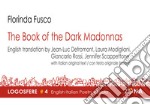Florinda Fusco eBooks
eBooks di Florinda Fusco
Florinda Fusco was born in Bari in 1972. She published poems and critical studies in several Italian reviews such as Il Verri, Nuovi Argomenti, Filologia Critica, Allegoria and foreign reviews such as The New Review, Aufgabe, The New Review of Literature, La Nouvelle Revue Française, Action Poétique, Siècle 21 etc. Her poems were published in collective works and in Italian and foreign anthologies such as Verso. L’immagine. Sulla soglia tra arte e poesia (Fondazione Baruchello, 2004), Parola Plurale (Sossella, 2006), Nuovi Poeti Italiani (Tilgher, 2006), Ex.it (2013), Nouveaux Poètes Italiens (2004), Persecutor Persecuted. 13 Italian Poets Under Forty (2008), Feature (2008), Poésie Italienne D’Aujourd’Hui (2014). Her first book of poems is Linee (Editrice ZONA, 2001). Her second book Il libro delle madonne scure (Mazzoli, 2003), illustrated by Luigi Ontani, won the Delfini Prize. Florinda Fusco translated from Spanish into Italian the poems of the Argentine writer Alejandra Pizarnik, and this work was awarded the Italian Prize for translators Bernard Simeone (2004). In 2009 she published the book of poems Tre opere, and in 2011 the book Thérèse (Polìmata), a collection of poems, proses, drawings and photos. She worked from 2012 to 2017 with the performing arts research group Opera for the projects Ma. Hands Holding the Void and Film. Machine of seeing and hearing, which have been performed at Festival dei Due Mondi in Spoleto and at Triennal in Milan. In 2017 she published the play Film. Macchina della vista e dell’udito (La Camera verde). She published many essays of contemporary Italian literature, and in particular about Amelia Rosselli, Edoardo Cacciatore, Italo Calvino. Her poetic work has been translated in English, French and Spanish.
The book of the dark madonnas. E-book. Formato PDF Florinda Fusco - Editrice Zona, 2020 -
The compositional tension in Florinda Fusco’s poetry relies upon a form which is freed from metrical schemes, but depends, on the contrary, on a visual logic essentially defined by blank spaces. Pseudoverses strive towards an expanded form, broken and persistent at the same time: it’s a visual and rythmic continuum wherein typographical blanks are not only overwhelming but strictly speaking define a poetical structure. In short, they are a speaking silence, which sets in motion a specific tension between osmosis and struggle, between a drive to expression and aphasia, between an ambition to meaning and non sense.
